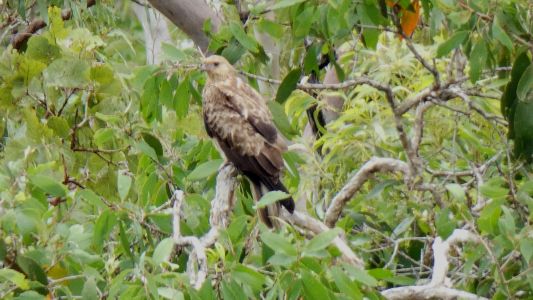With the clarity of hindsight we probably should have booked two nights at the rainforest.
We had a chuckle at the incongruous nature of the "keep off the grass" sign in front of the interpretive information signs.
Logistics through Portland Roads, there were apparently up to 7,000 military personnel hidden in the bush beside a sealed road. The bush provided camouflage for both the road and all the camps.
We don't know if the route for the road is the same as the current one. We can understand the rainforest providing cover but when we look at satellite images the road is quite clear. Perhaps the vastness of the landscape helped.
Something we found interesting was the compromise in airfield design, between short taxi runs due to poor engine cooling for planes while taxiing and the need to keep planes hidden and away from the runway when parked. The initial design changed over time as usage grew.
May 1942, shortly after the Coral Sea Battle, a Dragon Rapide landed on Chilli Beach on a reconnaisance flight. The team walked to Portland Roads (about 10km on current roads). Gordon was a local gold miner and must have provided some information.
Airfield construction started soon after.
The airfield served as a base for aircraft attacking Rabaoul (in then New Britain) where the Japanese had a large base.
I somehow doubt it will ever be re-opened. But it would be nice.
In the meantime we'll add it to the list of national park attractions that are closed when we arrive.
There is a string of old volcanoes down the eastern coast of Australia, all the way to Tasmania. One theory suggests one or more stationary hot spots that the Australian plate moved over. The volcanoes become younger further south so the plate must have been moving northwards. There is a lot of research to be done for someone.
Perhaps Mt Tozer was the source of the granite which has formed Iron Range. There has been no info on the park geology. We imagine the park seems to be east of and separate to the Great Dividing Range.

Time for showers. Though not necessarily because of the kite.
The paper barks are quite magnificent highlighted in the sun.
There are no ripples on the far side. Which means the croc Ali saw isn't awake yet, has eaten too much and is resting, has moved back to the river, or is stalking us. We will probably never know. We feel a little better about collecting water for laundry ... make it quick.
A slight breeze arrived a little later to disturb the water. A breeze so slight we could hardly feel it.
Its a Red-Browed Firetail. A member of the finch family.
We also were visited by Tony who informed us we were on private property, with camping not allowed. The site has been removed from WikiCamps. If I understood correctly we can leave tomorrow, and don't leave a mess. A generous approach to moving people on that can never be an easy task. We appreciate the extra night in a beautiful spot.
Perhaps too close to a new commercial campsite?
The land is part of Picaninny Plains, about 20km to our west for crows, longer by road. If we recall correctly from the very large gate where the road north and the Weipa road separate, an Australian Wildlife Centre.
While they are decidedly (in our ever so humble opinion) red-browed firetails there's a marking near their necks that is indistinct or absent.
Since we don't consider ourselves particularly skilled at bird watching (we've eventually had to accept that is what we are doing, though we are more opportunistic than its our main purpose in being here) there is a small sense of achievement in just seeing them, and moreso in taking a pic.
Perhaps also a bit of excitement as we see parts of nature we wouldn't have seen without really looking. We have a sense of seeing more than we used to, while there is even more that we miss.
We are beginning to connect vegetation and birds.
There are lots of forest noises. We wondered what the raucous sound was from the far side of the lagoon, that carried on for about a half hour.
We should have recognised the sound of blue-winged kookaburras. Though we last heard them at Millstream in May last year. Here we have just a brief glimpse of them in trees a hundred meters away. But sufficient to recognise them and take a hazy pic for the archives. Their sounds traveled a long way.
For some reason we endeavour to ignore crows.
A honeyeater (possibly white-throated) made an appearance but insisted on hiding behind leaves. There have been other birds that are even more elusive.
Croc watching will have to wait for another day. We haven't seen any indications. Just more secretive than the birds?
The lilly flowers opened as the sun shone on them in the morning, and have now closed for the day.